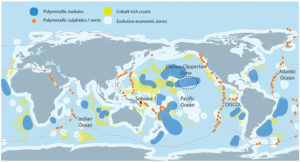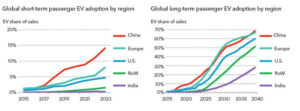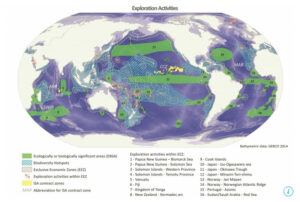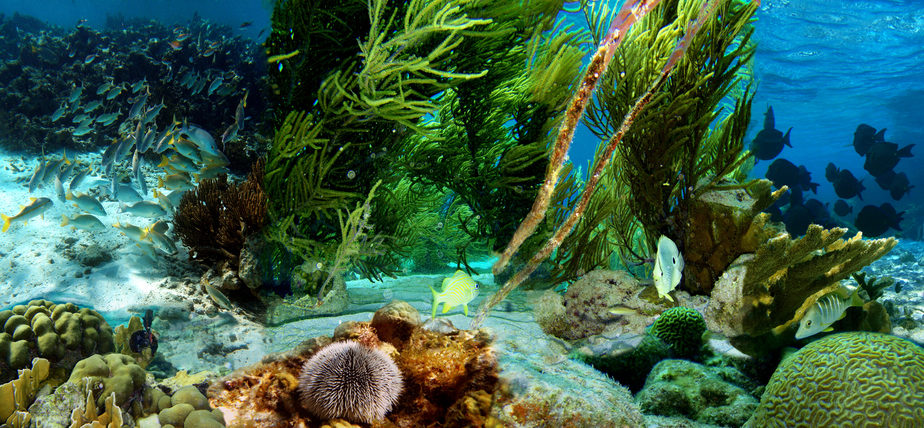In 1997, an experiment was conducted in the Central Indian Ocean Basin in the middle of diverse underwater ecosystems. In a small area on the ocean bed, a ‘disturbance’ was caused. When an impact assessment was studied post the disturbance, it was found that there was a change in the physic-chemical conditions of the waters. The study also indicated a reduction in biomass.
The experiment aimed to mimic the impacts of deep-sea mining—a process that retrieves mineral deposits from below 200m of the ocean. More specifically, the experiment was a result of an industry buzz surrounding potato-sized nodules on the ocean floor containing Copper, Nickel, Cobalt, as well as Manganese and Iron. Once out of water and processed, these elements are used in smartphones, and green technologies like wind turbines, solar panels, and batteries for Electric Vehicles (EVs).
Considering the impact underwater that the above experiment showed (one of several similar experiments carried out between 1972-1997!), it seems that ‘green’ energy solutions like solar panels and EVs may not have a green supply chain. Regardless, the race to reach the bottom of the ocean has piqued much interest across the world. While the initial phase of this exploration ended by 1982, a new phase of commercial interest re-emerged by the 1990s.
The International Seabed Authority (ISA), a UN authority, was set up to regulate the exploration and exploitation of marine non-living resources residing in oceans, and thus in international waters. As of May 2019, it has issued 29 licenses to countries across the world for deep-sea mining, including to India.

Currently, India holds exclusive rights to explore these polymetallic nodules in the seabed of Central Indian Ocean Basin, giving the country access to about 75,000 sq km of the seabed, containing an estimated bounty of 380 million tonnes of such nodules. In 2018, in order to explore this vast area, a five-year plan was devised, with Rs 8000 crore set aside for the same. Further, last year saw the launch of a new coastal research vessel off the shores of Kolkata, whose functions included ‘developing deep-sea technology’ amongst others.
But, is this marine exploration economically and ecologically viable?
Is it worth the money?
Cobalt, one of the minerals found underwater has witnessed the largest demand from the Rechargeable battery industry, which caters to batteries found in laptops, EVs, and electric grid storage. Currently, in India, the demand for cobalt is usually met through imports. But do we need to turn to the ocean bed at all to meet rising demand? Or alternatively, is there really an increasing demand for Cobalt at all?
Looking specifically at the market of Electric Vehicles in India, there has not been much of a shift from conventional fuel-driven vehicles; currently, two- and three-wheelers dominate this market. Expensive EVs, and the lack of a supporting ecosystem such as public charging points contribute towards the slower pace of this shift. It is not surprising then, that barely 8,000 EVs were sold nation-wide over the past six years, according to data compiled by Bloomberg. A similar assessment needs to be conducted for other perceived demands, to assess if we really need to engage in deep-sea mining to the extent that we are.

Moreover, metals recovered by means of deep-sea mining need to be mined competitively with land-based reserves to be able to compete in the world metal markets, as pointed out by a paper. For this to be possible, the process needs the support of efficient technology, which is still under development. Even up till now, there does not seem to be any established technical or economic viability for exploiting deep-sea nodules.
The latest experiment with Deep sea mining in Papua New Guinea this year turned out to be a ‘total failure’, as stated by the country’s Prime Minister James Marape. With dried-up funding, legal challenges and strong community resistance, major creditors are currently seeking to recoup about 157 million Australian Dollars that have been sunk into the project. Stakeholders involved in the project all have one thing to say–the risks and consequences of deep-sea mining are not well understood yet.
Deep sea mining is not the solution to providing minerals for renewable tech’s. Why do foreign mining companies, including Canadian ones like DeepGreen, think it’s ok to destroy the local env in other countries? -Jonathan Mesulam, Papua New Guinea #cdnpoli #TurningDownTheHeat pic.twitter.com/TIWBzd0eaR
— Dale Marshall (@CCDale) November 14, 2019
The Ecological Footprint
Life under the sea has always been shrouded in mystery. A vast majority of the deep-sea environment remains unexplored and thus, so are the dangers related to deep-sea mining. Not only have general concerns been raised over how the scraping of the ocean floor by machines can alter, or potentially wipe out an entire species’ ecosystem including their structure and function, environmental impact studies have also been carried out to indicate impacts of the same.
A study carried out under the Environment Impact Assessment for nodule mining in Central Indian Ocean Basin funded by the Ministry of Earth Sciences indicates that offshore mining would disturb an area of 300-600 sq km in its quest to mine 1.5-3 million metric tonnes of nodules per year. One of the impacts of such disturbances would be turbidity, which would hamper available sunlight and thus photosynthesis. This would have long term negative effects on biological productivity. It takes only that much to tip the delicate ecological balance of these environments.
What is worrisome is that many of the exploration activities within Exclusive Economic Zones have been in biodiversity hotspots, as a map by IUCN shows.

Preparing Ourselves
While intensive and independent impact assessments are needed currently, comprehensive baseline studies of what species live in the deep sea also need to be undertaken in order to understand how they would be affected by mining activities.
For both within territorial waters and beyond, there is a need for regulations. At present though, all the focus is on the “research” aspect of deep sea mining, and on associated technologies and biodiversity, which is also reflected in the National Mineral Policy, 2019. Under the policy’s “Research and Development” section, “deep sea mining” finds a space, but no details of regulation are mentioned.
Beyond territorial waters of countries, when it comes to the regulation of international waters the International Seabed Authority (ISA), established by the United Nations Convention on the Law of the Sea, steps in. The Convention has a few sections which are of significance to deep sea mining. However, these have faced criticism for containing vague definitions (the definitions of ‘acceptable harm’, or measurement of ‘harmful effects’ being cases in point). The ISA is currently developing their own regulations, which are being discussed in the authority’s sessions.
While laws can take care of ensuring that the ‘supply’ of polymetallic nodules is regulated, efforts to lower their demand can lighten the pressure off the deep sea nodules. Take for instance the recent partnership between MG motors and Exicom for second-life use of ZS EV batteries. The partners plan on reusing the battery after its initial use by utilising it in a host of non-automotive applications such as home inverters, commercial and industrial UPS’, and renewable energy storage facilities.
Seems like @MGMotorIn is doing a serious & a better job than any other OEM, that launched their e-cars in India, to create a hassle-free ecosystem (right from charging solutions to battery disposal & recycling) for e-cars enthusiasts and customers.#MGZSEVhttps://t.co/BdquFzhShs
— Anirudh Narla (@narla_anirudh) December 2, 2019
In a time where green solutions are making their way into the market, it is important to trace back their supply chain to understand exactly how ‘green’ the footprint is that they are imprinting. If the demand for solar grids or Electric Vehicles is to rise, it cannot be at the cost of an impaired undersea ecosystem.
This article is the final instalment of our series ‘In the name of Green Solutions.’ Featured Image Courtesy: Michal Strzelecki, Wojtek Strzelecki i Jerzy Strzelecki | By CC







[…] which needs to be extracted through deep-sea mining”. This, if not regulated, also has huge ecological impacts on marine […]